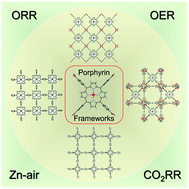Porphyrin-based frameworks for oxygen electrocatalysis and catalytic reduction of carbon dioxide
Abstract
Porphyrin-based frameworks, as specific kinds of metal–organic frameworks (MOFs) and covalent organic frameworks (COFs), have been widely used in energy-related conversion processes, including the oxygen reduction reaction (ORR), oxygen evolution reaction (OER) and CO2 reduction reaction (CO2RR), and also in energy-related storage technologies such as rechargeable Zn–air batteries. This review starts by summarizing typical crystal structures, molecular building blocks, and common synthetic procedures of various porphyrin-based frameworks used in energy-related technologies. Then, a brief introduction is provided and representative applications of porphyrin-based frameworks in ORR, OER, Zn–air batteries, and CO2RR are discussed. The performance comparison of these porphyrin-based frameworks in each field is also summarized and discussed, which pinpoints a clear structure–activity relationship. In addition to utilizing highly active porphyrin units for catalytic conversions, regulating the porous structures of porphyrin-based frameworks will enhance mass transfer and growing porphyrin-based frameworks on conductive supports will accelerate electron transfer, which will result in the improvement of the electrocatalytic performance. This review is therefore valuable for the rational design of more efficient porphyrin-based framework catalytic systems in energy-related conversion and storage technologies.

- This article is part of the themed collection: Small molecule activation, from biocatalysis to artificial catalysis


 Please wait while we load your content...
Please wait while we load your content...